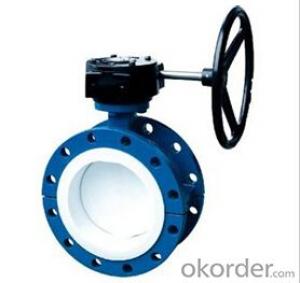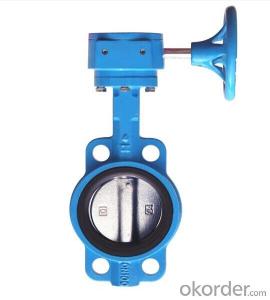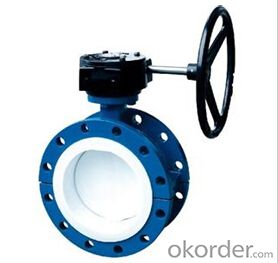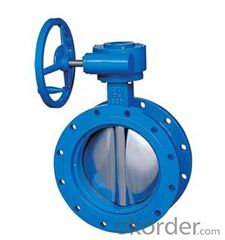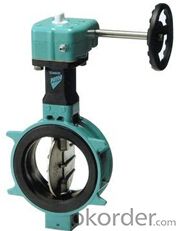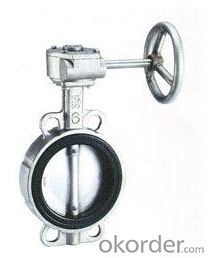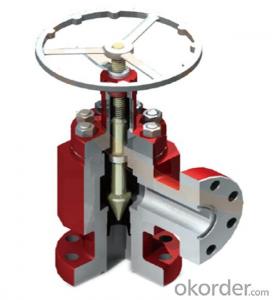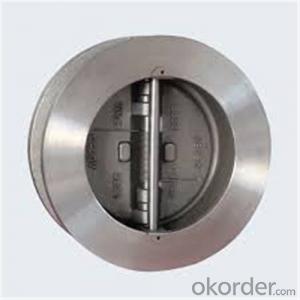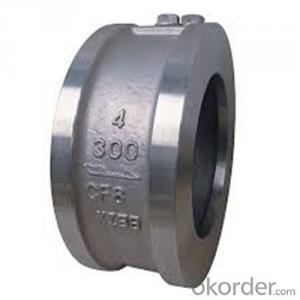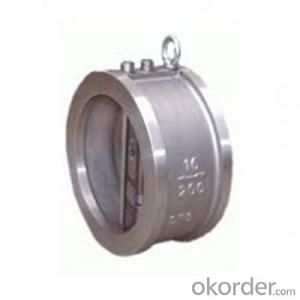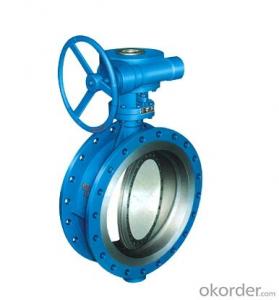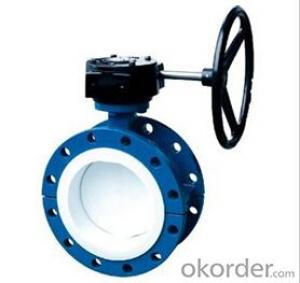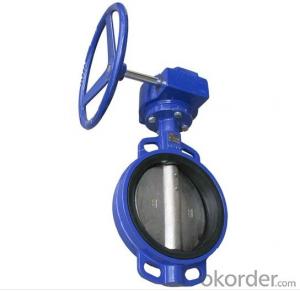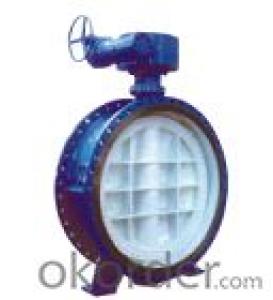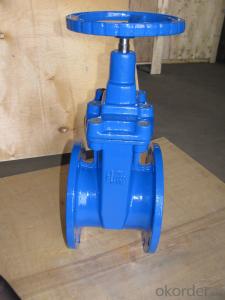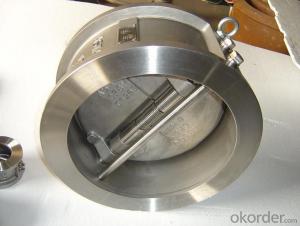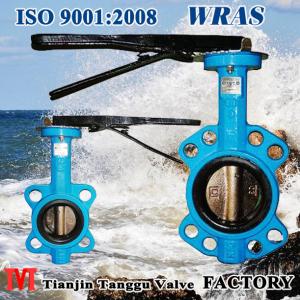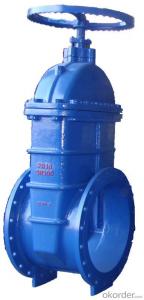DN800 Turbine Type Butterfly Valve with Hand wheel BS Standard
- Loading Port:
- Tianjin
- Payment Terms:
- TT OR LC
- Min Order Qty:
- 1 set
- Supply Capability:
- 5000 set/month
OKorder Service Pledge
OKorder Financial Service
You Might Also Like


General valve using the market long-term, widespread Water Leakage, rust phenomenon, soft sealing gate valve produced by the introduction of foreign advanced technology of the enterprise. To overcome the poor sealing gate valve, general elastic fatigue, rust and other defects. Soft sealing gate valve is a traditional valve replacement products, the compensation effect of using flexible gate produce small deformation, achieve good sealing effect, the valve has a light switch, reliable sealing, good elastic memory and long service life and other significant advantages, can be widely used in water, sewage, construction, food, medicine, metallurgy, electric power, textile, energy systems, fluid pipeline regulation and closure devices as.
The characteristics of:
- flat style seat
The traditional control valve often pass after washing due to foreign objects such as stone, wood, cement, paper, and other debris deposited on the valve at the end of the groove. Close but not close easily lead to the formation of Water Leakage phenomenon, the lower part of the soft sealing gate valve with water using the same flat design, easy to siltation caused by debris, the fluid unimpeded.
And the overall package glue
The valve plate is made of high-quality rubber overall, the outsourcing of plastic, making the domestic first-class rubber vulcanization vulcanization after the valve plate to ensure accurate geometry, and the rubber and ductile iron gate is connected firmly, not easy to fall off and good elastic memory.
And corrosion resistance
The valve body adopts epoxy coating powder, can prevent the corrosion and rust, and can be used for sewage systems.
And not easy to break
Traditional cast iron garden gate often hit foreign objects, collision or overlap caused by the fracture phenomenon. Because the valve to switch to ductile iron, this is the case already significantly reduced.
Three "O" ring seal
As the valve stem with three "0" ring ring seal design, can reduce friction when the switch is greatly reduced, Water Leakage phenomenon and can cut off the water supply construction not replace sealing ring.
And help to drink
Due to the internal body to non-toxic epoxy resin coating, gate of the inner and outer surfaces are completely coated with rubber and can not rust or corrosion of water available to drink.
- Casting valve
Valve body casting, precise geometry makes the body without any internal finishing to ensure that the valve seal.
And light weight
The valve is made of ductile cast, lighter in weight than conventional gate weight about 20%-30%. Convenient installation and repair.
Overview:
General valve using the market long-term, widespread Water Leakage, rust phenomenon, soft sealing gate valve produced by the introduction of foreign advanced technology of the enterprise. To overcome the poor sealing gate valve, general elastic fatigue, rust and other defects. Soft sealing gate valve is a traditional valve replacement products, the compensation effect of using flexible gate produce small deformation, achieve good sealing effect, the valve has a light switch, reliable sealing, good elastic memory and long service life and other significant advantages, can be widely used in water, sewage, construction, food, medicine, metallurgy, electric power, textile, energy systems, fluid pipeline regulation and closure devices as.
The characteristics of:
- flat style seat
The traditional control valve often pass after washing due to foreign objects such as stone, wood, cement, paper, and other debris deposited on the valve at the end of the groove. Close but not close easily lead to the formation of Water Leakage phenomenon, the lower part of the soft sealing gate valve with water using the same flat design, easy to siltation caused by debris, the fluid unimpeded.
And the overall package glue
The valve plate is made of high-quality rubber overall, the outsourcing of plastic, making the domestic first-class rubber vulcanization vulcanization after the valve plate to ensure accurate geometry, and the rubber and ductile iron gate is connected firmly, not easy to fall off and good elastic memory.
And corrosion resistance
The valve body adopts epoxy coating powder, can prevent the corrosion and rust, and can be used for sewage systems.
And not easy to break
Traditional cast iron garden gate often hit foreign objects, collision or overlap caused by the fracture phenomenon. Because the valve to switch to ductile iron, this is the case already significantly reduced.
Three "O" ring seal
As the valve stem with three "0" ring ring seal design, can reduce friction when the switch is greatly reduced, Water Leakage phenomenon and can cut off the water supply construction not replace sealing ring.
And help to drink
Due to the internal body to non-toxic epoxy resin coating, gate of the inner and outer surfaces are completely coated with rubber and can not rust or corrosion of water available to drink.
- Casting valve
Valve body casting, precise geometry makes the body without any internal finishing to ensure that the valve seal.
And light weight
The valve is made of ductile cast, lighter in weight than conventional gate weight about 20%-30%. Convenient installation and repair.


- Q: I dont want to buy an expensive snorkel, because I only want the valve. Its for a project for a club where I go to college.
- try amazon and OKorder
- Q: My 97 Tahoe has a leaking A/C pressure valve. I went to charge the system yesterday, and when I finished I took the hoses from the charging gauges off. The pressure side valve leaked. I pressed it down with a small screwdriver yet still couldn't get it to seat. I looks like it might have a damaged seal around the valve.Can I replace the valve? And if so, how. Or do I have to replace the entire hose assemble as they connect to the compressor?Thanks
- You will have to evacuate the A/C system of it's freon to replace that schraeder valve.There is a tool that is similar to the one used on valve stems on tires that you might get and just try to tighten it first. That tool can be found at automotive A/C supply stores. Don't try to use anything else or you might mess it beyond repair. If you replace the hose you will also have to evacuate the system. I would try tightening it first. Also I've seen people just put a good o-ring under the cap that goes on it and tighten the cap real tight to avoid having to evacuate the system.
- Q: Glob Valve or Gate Valve
- Globe valve is used commonly
- Q: where in the engine is the heater control valve located on a 2001 toyota corolla
- standing okorder / sign up and post in the 8th gen corolla forum. great ppl. been a member for years.
- Q: Also what prevents this from occuring? I have a lab due tomorrow for my biology class this is one of the questions. the answer is no where in my book, and we haven't discussed this in class. im also having a hard time finding the answer online. i would assume it would have something to do with the elasticity of the valves, and i know that when valves are weak sometimes blood can flow back into the artium when the ventricle contracts causing a heart murmur and other problems, but i haven't came across any information that talks about the valve being pushed backwards. if you can help me out that would be awesome! thanks =]
- Valves, because they open when your heart pumps and close, not allowing blood to flow backwards after the pump.
- Q: I'm in the process of replacing my dishwasher but I have a problem. I followed the water line from the dishwasher to under my sink and found a red valve that was completely straight, so I turned it to the right as tight as it would go and tried removing the hex nut connecting the line to the dishwasher. Maybe i'm wrong, but there is a lot of water coming out of the line and I don't think it's supposed to. I easily filled up a bowl you would use to mix cakes and it was still going! So, I turned the valve back to straight across thinking maybe someone else turned it off (my dad), and tried it again but the same thing? What am I doing wrong and what should I do to solve this?
- either replace the valve or just turn water off at street remember being the lowest point of water service in your house once you turn it off at street or cut off all the water higher will travel to that point
- Q: I think I have a bad valve steam seals because when I start the car white-grayish smoke comes out of the back of the car. When let sit for 2 or more hours start car and smoke comes out everytime. Will a valve adjusment fix the problem? Thanks
- nope..time to have the head(s) done.....
- Q: does it moves up and down with the valve stem??
- Poppet valve is the commonly used term for a standard, mushroom- shaped engine valve.Obviously, the mushroom head is part of the valve, so yes, it does move up and down with its stem.
- Q: I've been working on cars since around march of 2012. I new. I have a set of 305 heads that were really dirty. It came from a 79 camaro that never had an Oil change. I took the valves out and the valves are pretty burnt. I was wondering If I cleaned them up would they still be good to use? The edges aren't rough or anything. Just let me know what is need to know please. The heads I know are still good.
- hey why dont you go down to your local machine shop and ask a few questions,try and angle a cleanup job to trade for labor and experience.in other words,why dont you go ask your dadlove that commercial
- Q: can you put a blow off valve on a chevy cobalt ss supercharged?
- A blow off valve is for turbo waste gate?not super charged
Send your message to us
DN800 Turbine Type Butterfly Valve with Hand wheel BS Standard
- Loading Port:
- Tianjin
- Payment Terms:
- TT OR LC
- Min Order Qty:
- 1 set
- Supply Capability:
- 5000 set/month
OKorder Service Pledge
OKorder Financial Service
Similar products
Hot products
Hot Searches
Related keywords
